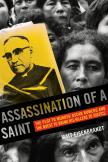The manhunt for a martyr’s killers
The Assassination of a Saint: The Plot to Murder Oscar Romero and the Quest to Bring His Killers to Justice begins slowly and at times its digression-heavy structure can be daunting, but before too long the inherent drama of the sorry tale of Archbishop Óscar Romero’s murder builds. Assassination begins like a crime thriller, complete with a criminal manhunt, before transitioning into a courtroom drama. Ultimately, however, the book’s lasting value is as a work of history.
While working through the investigation of the archbishop’s slaying and the increasingly tense hunt for one of his killers, readers are treated to commentary on Salvadoran history. The various digressions into the economy, history and complex political culture of El Salvador place Archbishop Romero’s murder and the unspeakable violence of the brutal civil war into context. This is an invaluable service, particularly for folks who may know about the death of Archbishop Romero but who may never have learned much more about the geopolitical and cultural circumstances of this terrible crime.
Matt Eisenbrandt certainly knows of what he writes. A human rights attorney who has made a career out of developing innovative legal strategies to prosecute war crimes and crimes against humanity, Eisenbrandt worked as the legal director at the Center for Justice and Accountability in San Francisco. As a member of the center’s trial team, he helped chase down one of the conspirators in Archbishop Romero’s assassination. Álvaro Saravia had “disappeared” in plain sight in the United States after fleeing El Salvador and his blood-drenched past. It is through the pursuit of this sociopathic cog in El Salvador’s machinery of death—a legal and literal odyssey across the hemisphere—that the role of other agents of Archbishop Romero’s assassination, and the complicity of U.S. policymakers in El Salvador’s great suffering, is brought to light.
Some of the excerpts of the often poignant courtroom testimony can be overlong, but this is a small quibble with a well-resourced and well-written work that offers a unique perspective on one of the great crimes of the late 20th century and the pursuit of justice that remains, regretfully, mostly denied.
This article also appeared in print, under the headline “The manhunt for a martyr’s killers,” in the February 20, 2017, issue.








